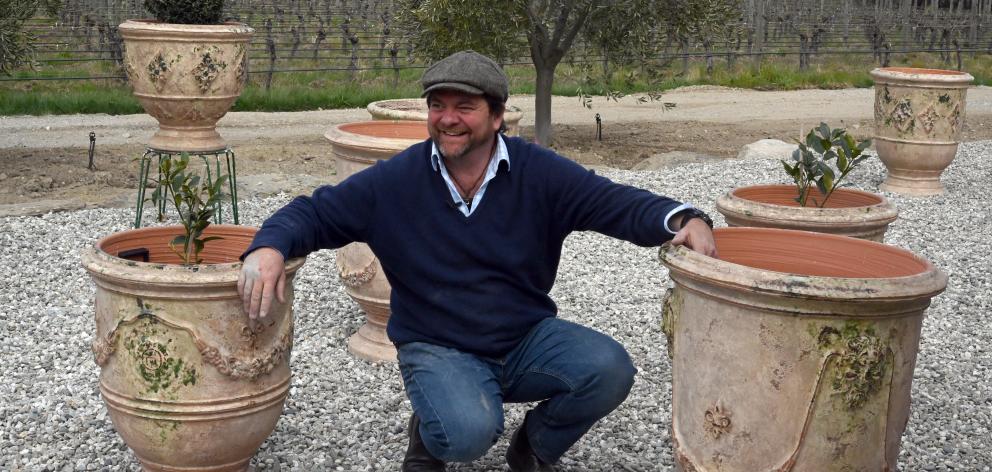Yannick Fourbet is fond of saying he is a Frenchman making New Zealand pots.
But that is not to say he has given up the traditions of his country's pot-making past, just that he is passionate about his work reflecting the country he now lives in.
Fourbet came to New Zealand a couple of years ago with his Kiwi wife - Philippa was born and raised on a farm near Lawrence - and young twin boys Augustin and Mortimer.

Like many expatriates who return home, they wanted to provide a more free upbringing for their sons.
''We figured it was the best place to be for the children to grow up,'' Fourbet says.

''It was three months, [then] we hopped on a plane to New Zealand.''
The idea was that Philippa, an investment banker in London for 15 years, would work part-time while Fourbet returned to what he was passionate about - making pots, especially horticultural pots.
Philippa got a job looking after investors and commutes to Wellington two days a week.
To turn his dream into a reality, the Fourbets constructed a purpose-built shed near the entrance to their Lowburn winery, Domain Rewa.
The shed provides room for Fourbet to make his pots as well as a viewing and tasting area for the winery's products and the pots.

Across the shed is what Fourbet calls the ''Rolls Royce'', a kiln imported from the same Spanish maker that constructed his French kiln.
The lpg-fired kiln takes 10 to 20 pots at a time, depending on their size, and requires 30 45kg bottles of gas to operate.
However, the most important and challenging part of the process has been finding the clay and perfecting the mix for his pots.
Sourcing clay cheaply from Europe was not an option, as it had to be heated to high temperatures before it was allowed into the country.
Instead, he is working with a Canterbury company to come up with the right consistency of clay.

He is also looking at adding ground recycled glass to the mix, as he did in France.
''Fine-tuning the clay is quite an experience. The first batch was too sticky, too hard.''
The clays are mixed with water in a second-hand industrial cake mixer Fourbet found in Wellington.
From there, he uses an age-old technique to construct his pots - one he discovered while watching an old man give a pot-making demonstration in a town in southern France.
''I thought it was quite extraordinary. He was under the hard, boiling sun so I went and got him a pitcher of water and asked if he would like a drink.''
They got chatting, with Fourbet explaining that he was a potter with a staff of 20, but would like to learn a more traditional method of making pots.
''So I asked if he would show me. He said, 'You know what? In 10 years you are the first person to bring me some water, so just for that I'll show you how to do it.' That was the beginning of the adventure.
''I wasn't much of a potter really, but learning with ropes and wood was perfect for me. I didn't have to hand throw anything and I could perpetuate this tradition.''
So Fourbet set up a wheel in his factory to make pots the old-fashioned way, but the business side got in the way.
Since moving into his new workshop, he has been busy making new templates from plywood for different sized and shaped pots.
The wooden frame of a pot is attached to the wheel before Foubert winds rope tightly around the frame.
''The electric motor is fantastic. It gives me enough torque to ensure the rope stays tight.''
He then slathers on the clay, with a wooden profile helping ensure it is kept to an even depth around the pot. The mouth of the pot then needs to be shaped so it is even.
''It is the first thing that is seen in a horticultural pot.''
Once it is complete, the pot is left to dry, with the help of wooden and foam supports. Then, as the pot dries, Fourbet removes some of the rope from the interior.
''If you take it out too early the pot will collapse. Take it out too late, and it will crack.''
The pots are then moved to the workshop's mezzanine floor to dry further, and stay there until they are ready to be glazed and decorated.
Just how long it will take for the pots to dry in the Central Otago climate is something he is still learning. Back in France it was six weeks to two months.
''It's a very harsh climate, very dry, so it might be shorter. It's a learning curve.''
When there are enough pots, Fourbet will fire them for 72 hours at 1250degC.
''It takes about a day for a 1m pot just to shape it, then you have to glaze it and put on patinas. I'm using about 150m rope for a 1m pot.''
Then there is the uncertainty of what happens in the kiln. If a tiny air bubble in the clay explodes, the pot will shatter and destory all the hard work that went into it.
The largest pot Fourbet made in France required 350kg of clay and was 150cm high and wide. His clients have included Christian Dior, the Palace of Versailles and the cities of Montpellier and Nice.
He is starting to experiment on different shapes of pots, in particular an amphora-shaped pot to be used in winemaking.
Fourbet plans to make three small amphoras for local winemakers, including their own, to trial.
''I'm not much of a winemaker, but I am a potter. It's a collaborative effort, a nice link to the vineyard.''
His other ''big project'' over the next few years is to create a ''typically Kiwi'' pot in shape, colour and decor.
In France, he created his antique patina to reflect the French countryside and it also sits well in the Central Otago landscape, with its burnt yellows and dry grass.
''I'd like to introduce aspects of New Zealand culture, colours. Something that when Kiwis travel the world ... they recognise as being truly from Central Otago, just like you recognise a French urn.''
This is where his background in selling antiques and marketing will come in handy. Before he bought into the pot business with his father in France, he was selling, sourcing and restoring antiques.
''I was always good with my hands and speaking English was quite convenient as I could interpret.''
Prior to that he got a marketing degree, having decided he was not cut out for the bright lights of a laboratory where he worked as a marine scientist.
''It wasn't the kind of life I wanted.''
Fourbet also travelled around Europe attending homeware and garden trade shows to showcase his work.
He hopes to do the same around Australia, Asia and the United States with his New Zealand-made pots.
So far he has had orders from Canada, Australia and the United Arab Emirates and also from a new local cafe.
''I didn't come here to make millions. I came here to have a good life and if I can live a good life making a living out of my trade, I'll be happy.''












